Ever wondered how to transform your bedroom into a peaceful retreat that balances simplicity with elegance? Japandi style—an enchanting blend of Japanese minimalism and Scandinavian coziness—has taken the design world by storm. Its popularity stems from its ability to create serene, clutter-free spaces that promote relaxation and mindfulness, all while maintaining a chic, modern aesthetic.
Whether you’re seeking a calming sanctuary or a stylish update, Japandi ideas offer the perfect harmony of form and function. In this article, you’ll discover a wealth of inspiring ideas and practical tips to bring the tranquil beauty of Japandi into your own bedroom.
From soothing color palettes and minimalist furniture to thoughtful decor accents, each concept is designed to help you craft a space that exudes balance and serenity. Get ready to explore a variety of sophisticated yet cozy design tricks that will elevate your bedroom into a peaceful haven you’ll love to retreat to every day.
1. Incorporate Neutral Color Palettes for Calm and Cohesion
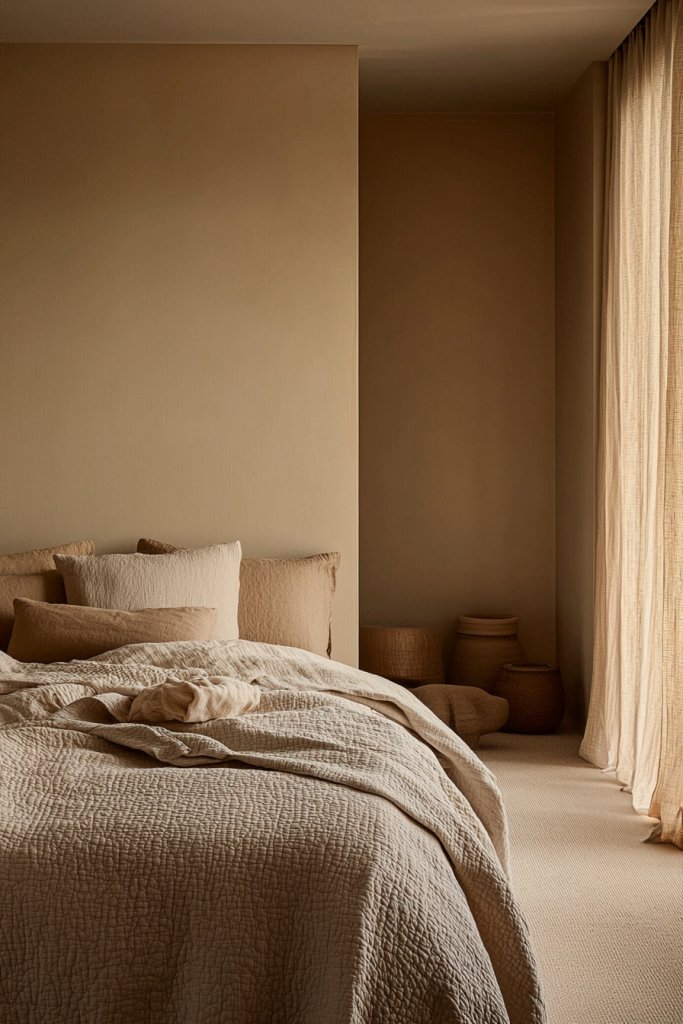
Creating a serene Japandi bedroom begins with a soothing neutral color palette that promotes calm and visual harmony. These hues—think soft beiges, warm creams, gentle greys, and muted browns—serve as a tranquil backdrop that helps reduce visual clutter and fosters a peaceful atmosphere.
Such colors are versatile, allowing natural light to bounce softly across the room, enhancing the sense of openness and balance that’s central to Japandi style. Imagine walking into a bedroom where the walls are painted in a warm, oatmeal tone, complemented by a bed dressed in crisp, ivory linens.
The floors and furniture are crafted from light or dark natural wood, adding texture without overwhelming the senses. The overall space feels airy and uncluttered, with subtle variations in shades that create depth while maintaining cohesion.
The muted palette invites relaxation, making the bedroom a true sanctuary for rest and rejuvenation. To achieve this look, start by selecting a neutral paint or wallpaper that sets a calm foundation.
Incorporate textiles like linen or cotton in soft shades, and choose furniture with natural wood finishes—either light oak or darker walnut—keeping accessories minimal. Balance is key, so avoid overly bright or busy patterns, instead opting for monochromatic or subtly patterned bedding and decor that blend seamlessly into the overall calm environment.
2. Choose Minimalist Bed Frames with Clean Lines
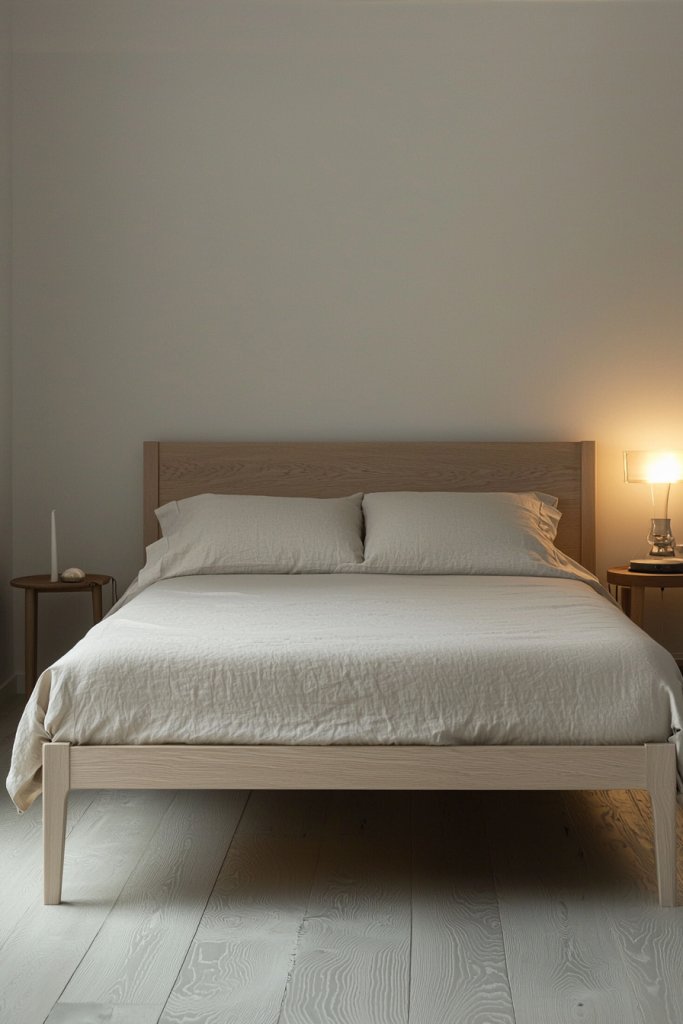
A cornerstone of Japandi bedroom design is a minimalist bed frame that embodies simplicity and functionality. Opt for a low-profile platform bed with sleek, straight lines—think unadorned wood or metal with a matte finish—that creates a modern yet timeless focal point.
The clean design emphasizes the beauty of natural materials and offers a sense of grounded stability, essential for achieving the tranquil aesthetic. Picture a bed with a simple, rectangular headboard made of light oak or blackened steel, positioned low to the ground to foster a sense of closeness to the earth.
The mattress is dressed in crisp, unembellished linens, perhaps with a subtle texture like linen or cotton. The space around the bed remains uncluttered, with space left for movement and relaxation, reinforcing the minimalist ethos of “less is more.” This approach makes the room feel spacious, calm, and balanced.
To recreate this, choose a bed frame with straightforward construction—skip ornate carvings or excessive detailing. Look for options made from natural woods or metal with muted finishes.
Keep bedding simple: a fitted sheet, a duvet cover in neutral tones, and a few plush pillows. This uncluttered foundation makes it easier to integrate other Japandi elements and creates a restful, visually soothing sleeping environment.
3. Use Soft Textiles and Bedding for Cozy Comfort
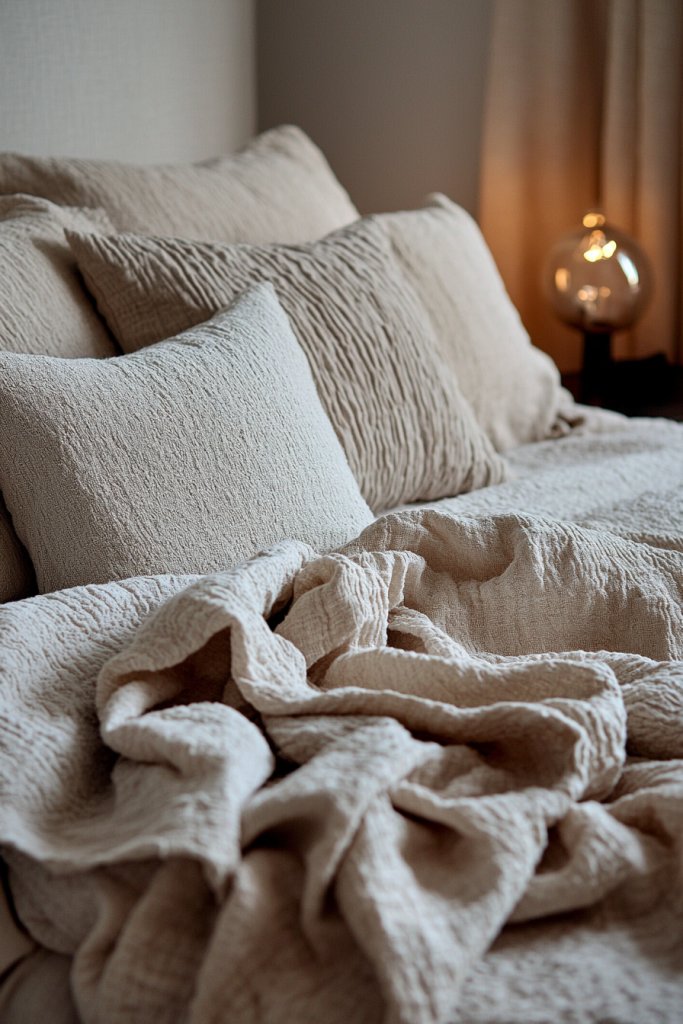
While Japandi decor emphasizes simplicity, it also values tactile comfort to make the space inviting. Soft textiles and bedding—such as plush throws, textured blankets, and high-quality sheets—add warmth and a cozy layer to the minimalist aesthetic.
These elements help balance the sleek lines and neutral tones, creating a space that feels both calm and welcoming. Envision a bed layered with a chunky knit throw in a neutral hue like warm beige or soft grey, draped casually at the foot of the bed.
The bedding is made from natural fabrics like linen or cotton, providing a breathable, soothing touch. Add a few decorative pillows with subtle textures—perhaps a woven cushion or a linen pillowcase—to invite touch and visual interest.
The overall effect is a bed that looks effortlessly cozy, encouraging relaxation and restful sleep. To implement this, select high-quality, neutral-colored linens and textured textiles.
Opt for a soft, thick duvet cover or a lightweight quilt, and layer with throws and pillows in complementary shades. Incorporate materials like linen, cotton, or wool for comfort and sustainability. By combining these textiles thoughtfully, you create a tactile experience that enhances the room’s serenity and makes everyday routines more pleasurable.
4. Opt for Natural Wood Nightstands and Dressers
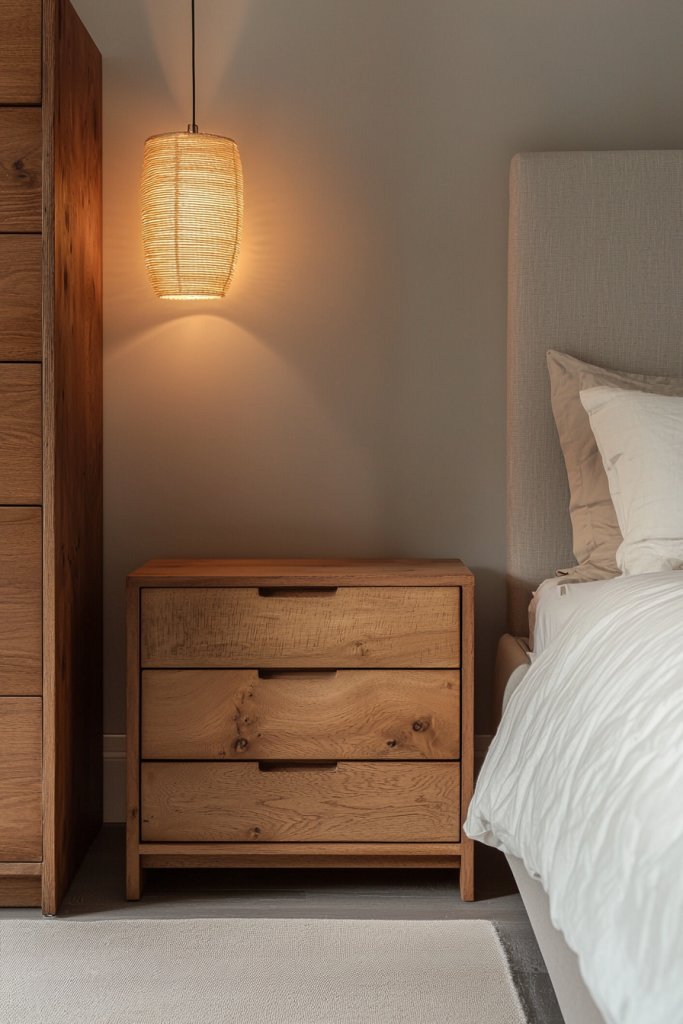
A natural wood nightstand or dresser can instantly bring warmth and tranquility to a Japandi-inspired bedroom, creating a seamless connection between nature and minimalism. Choosing authentic wooden furniture helps craft a serene oasis that feels both grounding and inviting.
Imagine a sleek, low-profile nightstand crafted from light oak or ash wood, its smooth surface showcasing the natural grain patterns that add subtle texture. Paired with a matching dresser, the furniture’s simple, clean lines emphasize craftsmanship and understated elegance.
The warm tones of the wood contrast beautifully with neutral wall colors—like soft beiges or muted greys—while textured textiles such as a linen throw or woven basket nearby enhance the tactile experience. The overall look is calm and cohesive, with the gentle scent of natural wood subtly filling the space, inviting you to unwind and relax.
To recreate this look, start by selecting natural wood furniture with a minimalist design—look for pieces with clean edges and an unembellished finish. You can find affordable options at furniture stores or consider DIY projects with unfinished or lightly stained wood.
Pair your nightstand and dresser with simple, unadorned bedding and soft textiles to complement the natural aesthetic. If you prefer an alternative, opt for furniture in bamboo or reclaimed wood for an eco-friendly touch. With just a few thoughtfully chosen pieces and a focus on natural materials, you’ll create a peaceful, balanced bedroom that embodies Japandi style.
5. Add Textured Rugs to Create Warmth and Depth
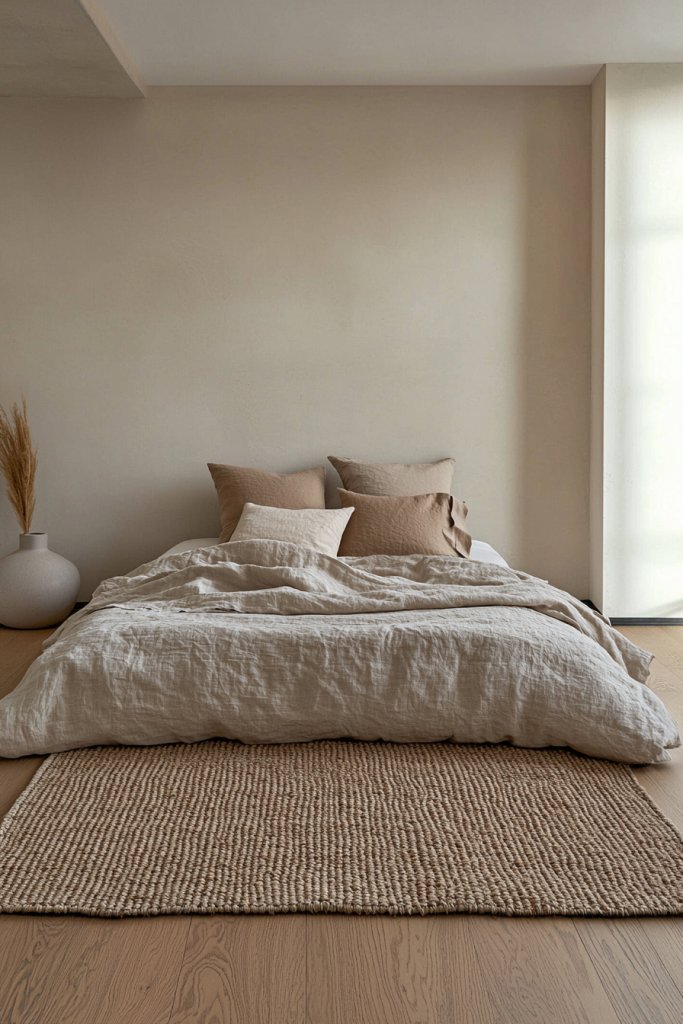
Adding textured rugs to your bedroom is a simple yet powerful way to infuse warmth and depth, transforming your space into a cozy sanctuary. This touch of tactile luxury helps break up sleek surfaces and adds visual interest, making the room feel more inviting and layered.
Imagine a plush, chunky-knit wool rug in a soft beige or warm taupe spreading beneath your bed, its thick fibers inviting your feet to sink in. Layered with a delicate woven jute or a subtly patterned linen rug, the textures create a rich tapestry that plays with light and shadow, enhancing the room’s calm atmosphere.
The tactile variety invites you to touch and explore, while the muted color palette maintains the serene, minimalist aesthetic. The overall effect is a space that feels both grounded and inviting, encouraging relaxation and comfort.
To recreate this look, start with a high-quality textured rug like a shaggy wool or woven jute, which can often be found at home goods stores or online. Choose neutral tones such as cream, soft gray, or warm beige to maintain the tranquil Japandi vibe.
Simply place the larger rug under your bed, leaving a border around the edges, and add a smaller, patterned or textured runner at the foot or side for extra visual interest. No complicated installation is needed—just unroll, position, and enjoy the cozy upgrade in your bedroom.
6. Select Simple, Functional Lighting with Warm Glows
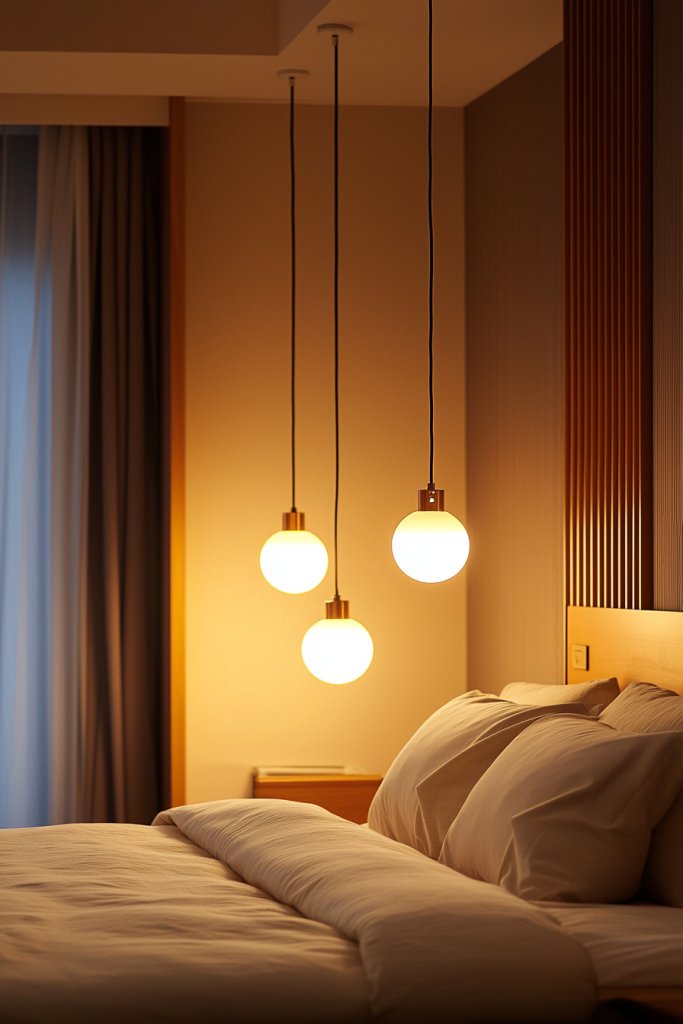
Lighting plays a crucial role in creating the tranquil, inviting atmosphere that defines Japandi style. Choosing simple fixtures that emit a warm, soft glow can dramatically enhance the serene vibe of your bedroom, making it feel cozy and balanced.
Well-selected lighting also emphasizes the minimalist aesthetic by avoiding clutter and focusing on clean, elegant forms. Imagine a bedroom softly illuminated by a pair of clay-colored ceramic table lamps with warm LED bulbs, casting a gentle amber light across the space.
Overhead, a simple paper pendant or a concealed LED strip can provide ambient light without overpowering the room. The key is to avoid harsh, bright bulbs; instead, opt for dimmable options that allow you to adjust the mood from lively to relaxed.
The warmth of the light should complement natural wood tones and neutral textiles, enhancing the calming environment. To achieve this, start with basic table or floor lamps featuring minimalist designs—think matte black or brushed metal finishes.
Use warm white bulbs (around 2700K) for a cozy glow. Place lamps strategically beside the bed or in dark corners to create balanced lighting zones.
If you prefer overhead lighting, consider installing dimmable ceiling fixtures with simple, understated shades. This approach ensures your space remains uncluttered while providing versatile, soothing illumination perfect for winding down or relaxing in the evening.
7. Incorporate Japanese-inspired Shoji Screens for Subtle Dividers
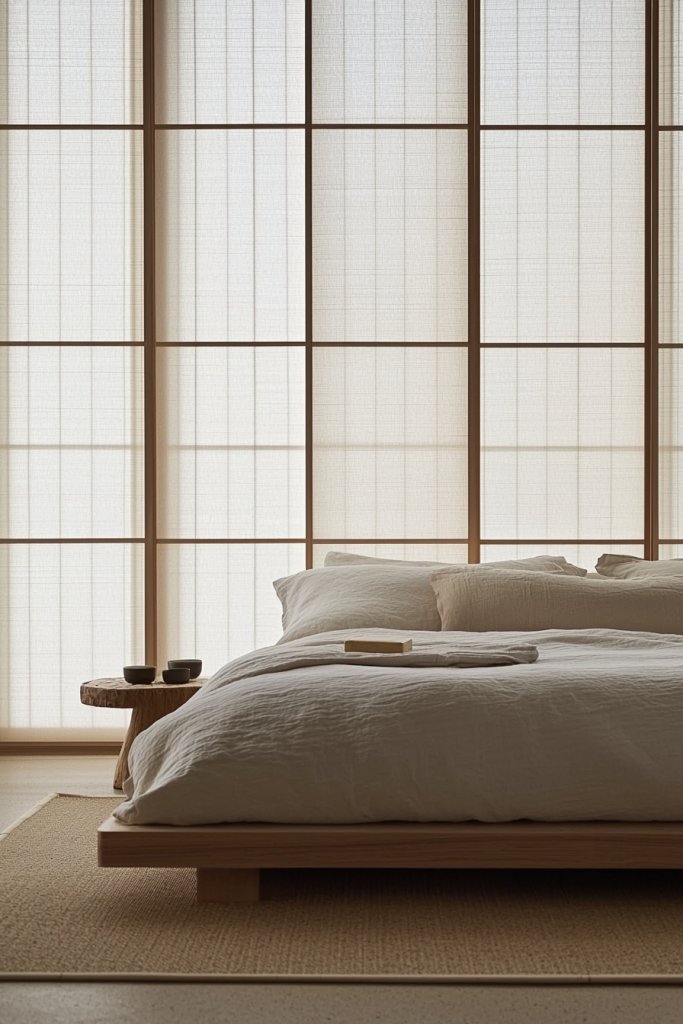
Shoji screens add a touch of traditional Japanese elegance to a Japandi bedroom while serving as versatile, subtle room dividers. Their delicate, paper-covered frames soften the space, creating zones of privacy or visual separation without blocking light or making the room feel cramped.
These screens embody the minimalist ethos, combining functionality with understated beauty. Visualize a bedroom with a light, airy shoji screen made from slim wooden frames and translucent rice paper panels.
The screens are positioned near the bed or used as a backdrop behind a seating area, adding texture and visual interest. The soft glow filtering through the paper creates a serene, diffused light that enhances the room’s calm atmosphere.
Their neutral wood tones and clean lines complement the overall natural palette, while their lightweight construction allows easy repositioning to change the spatial flow. To incorporate shoji screens, start by selecting a pre-made panel or kit that matches your room’s dimensions.
Place them strategically to define different zones—such as separating a sleeping area from a reading nook—without sacrificing openness. For a more budget-friendly approach, consider DIY kits or repurposing slim wooden frames with custom paper or fabric panels. Keep the design simple and avoid overly ornate details to maintain harmony with the Japandi aesthetic, focusing on light, natural materials that evoke tranquility.
8. Style with Ceramic Vases and Decorative Bowls
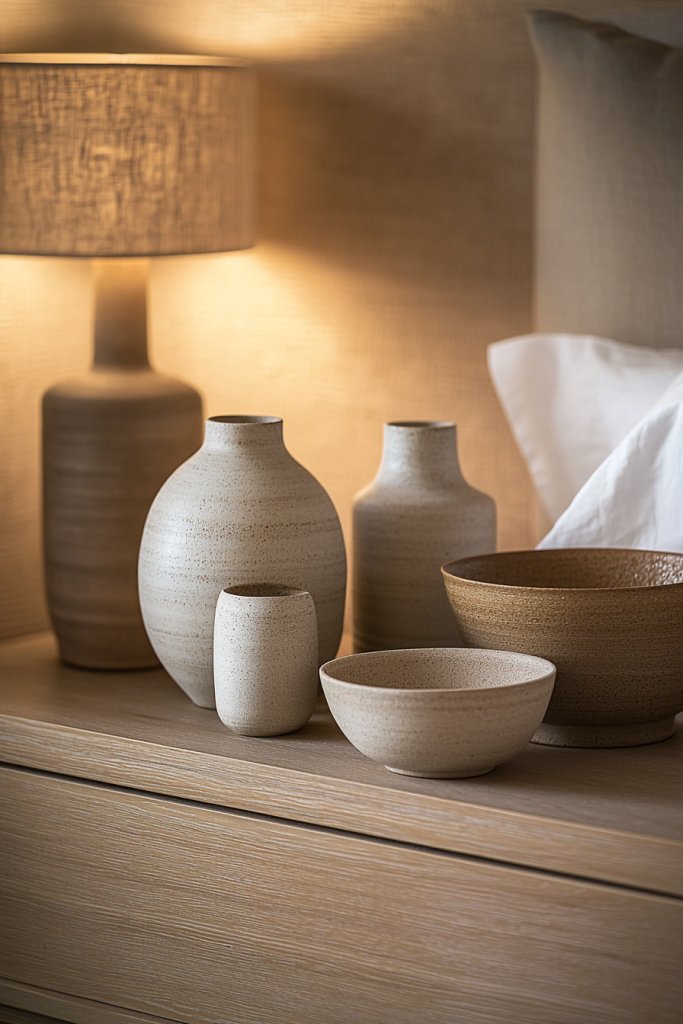
Ceramic vases and bowls are essential decorative elements that bring both texture and cultural nuance into a Japandi bedroom. Their understated elegance and natural finishes add visual interest without clutter, helping to balance minimalism with a touch of handcrafted charm.
These objects serve as focal points or subtle accents that enhance the room’s overall serenity. Picture a sleek, matte ceramic vase in muted beige or charcoal, holding a single dry branch or a simple bouquet of dried grasses.
Nearby, a smooth ceramic bowl in earthy tones sits on a low bedside table, perfect for holding small items or simply serving as a decorative piece. The tactile qualities of these ceramics—glossy, matte, or textured—add depth and warmth to the space, inviting touch and contemplation.
Their organic shapes and neutral colors seamlessly blend with natural wood furniture and soft textiles. To style your bedroom, choose ceramic pieces with simple, clean lines and natural finishes—think unglazed or matte glazes in shades inspired by earth or stone.
Mix and match different sizes and shapes for visual variety, but keep the palette cohesive. Place them thoughtfully on side tables, shelves, or window sills, and consider pairing them with other neutral or textured decor elements. These ceramics will subtly elevate your space, creating a harmonious and inviting environment perfect for rest and reflection.
9. Use Low-Profile Platform Beds for a Modern, Grounded Look
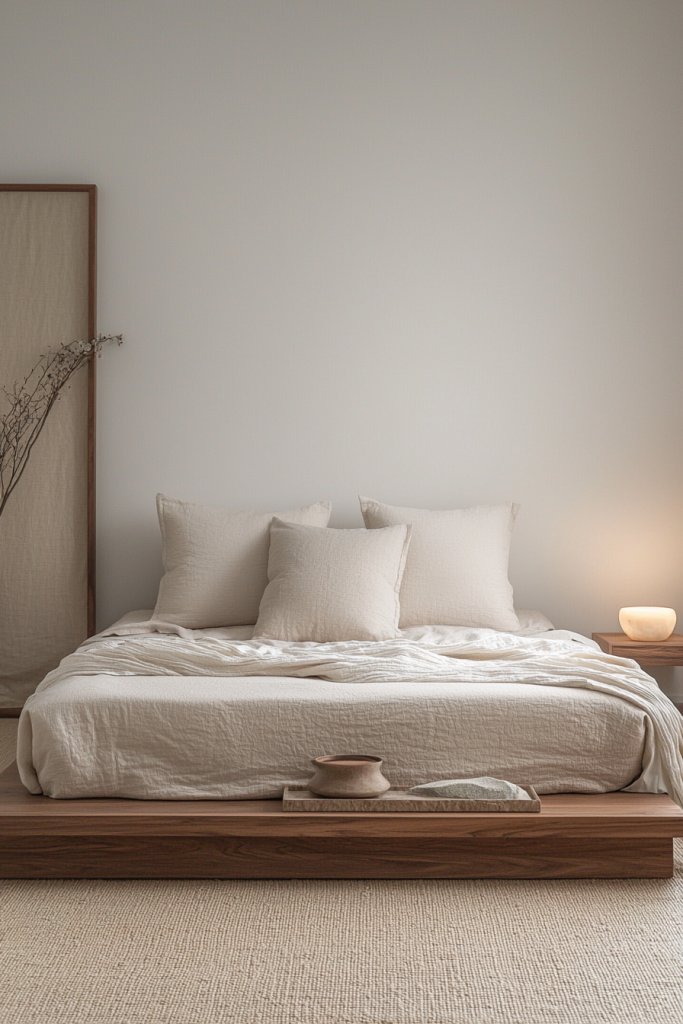
A low-profile platform bed embodies the minimalist, grounded aesthetic of Japandi style, providing a sleek, modern foundation that emphasizes simplicity and comfort. Its clean lines and unobtrusive presence keep the room feeling open and calm, while its close-to-the-floor stance aligns with traditional Japanese design principles of humility and connection to the earth.
Imagine a bed with a slim, matte black or natural wood frame that sits just above the floor, topped with crisp, neutral bedding. The mattress appears to gently rest on the platform, creating a seamless, uncluttered silhouette.
The low height makes the space feel more expansive and allows for easy access, fostering a sense of tranquility and ease. The overall look is modern yet warm, grounded in natural materials that harmonize with the room’s neutral palette.
To recreate this look, choose a low-profile platform bed made from light-colored wood or engineered wood with a simple headboard or no headboard at all. Keep bedding minimal—think a soft cream or taupe duvet, with a few textured pillows or throws.
Pair the bed with under-bed storage or a simple rug underneath to add warmth and functionality. This approach results in a calming, cohesive sleeping area that feels both modern and inviting, perfect for embracing Japandi’s balance of form and function.
10. Integrate Organic-Shaped Mirrors to Enhance Serenity

Organic-shaped mirrors introduce a natural, flowing element into a Japandi bedroom, softening rigid lines and adding visual interest while amplifying the sense of calm. Their irregular, freeform shapes evoke natural forms like stones or water ripples, reinforcing the connection to nature that’s central to the Japandi aesthetic.
These mirrors also enhance light and space, making the room feel larger and more luminous. Picture a large, organically shaped mirror with a wooden or matte black frame, hung above a simple wooden dresser or leaning against a wall.
Its irregular silhouette creates a focal point that draws the eye and adds a touch of artistic elegance. The mirror’s reflective surface amplifies natural light, making the room feel brighter and more open.
The soft curves and natural materials of the mirror complement the room’s neutral palette and textured textiles, creating a harmonious, peaceful atmosphere. To incorporate an organic-shaped mirror, look for handmade or artisanal pieces that emphasize natural forms.
Hang it at eye level or lean it against a wall for a casual, effortless vibe. Pair it with other natural materials—like wood, linen, or ceramics—to reinforce the tranquil, organic feel. This simple addition can transform your space into a sanctuary of serenity, balancing modern minimalism with nature-inspired softness.
11. Add Subtle Metal Accents in Black or Brushed Nickel

Incorporating subtle metal accents can elevate a Japandi bedroom’s understated elegance without overpowering its serene aesthetic. These small touches add a refined contrast to the natural woods and soft textiles typical of the style, creating a balanced, polished look.
Metal details in black or brushed nickel are particularly versatile, offering a modern yet warm touch that enhances the overall calm vibe. Imagine a sleek black metal drawer handle on a low wooden dresser, or a brushed nickel trim on a minimalist mirror frame.
These accents should be delicately placed, such as in lighting fixtures, drawer pulls, or small decorative objects, to maintain the room’s tranquil atmosphere. The metals’ matte or satin finishes diffuse light softly, adding a subtle shimmer that catches the eye without disrupting the peaceful environment.
The overall effect is one of quiet sophistication that complements the natural and organic elements of Japandi design. To incorporate these accents, start by selecting a few key details—like black metal lamp bases, matte-finish hardware, or a brushed nickel picture frame.
Keep the finishes consistent to unify the space visually. You can find these pieces at furniture stores or online, often at accessible price points. A simple switch from shiny to matte or textured finishes makes a significant difference, allowing you to effortlessly add a stylish, modern edge that pairs beautifully with natural textures and muted tones.
12. Display Minimalist Clocks and Functional Decor Pieces
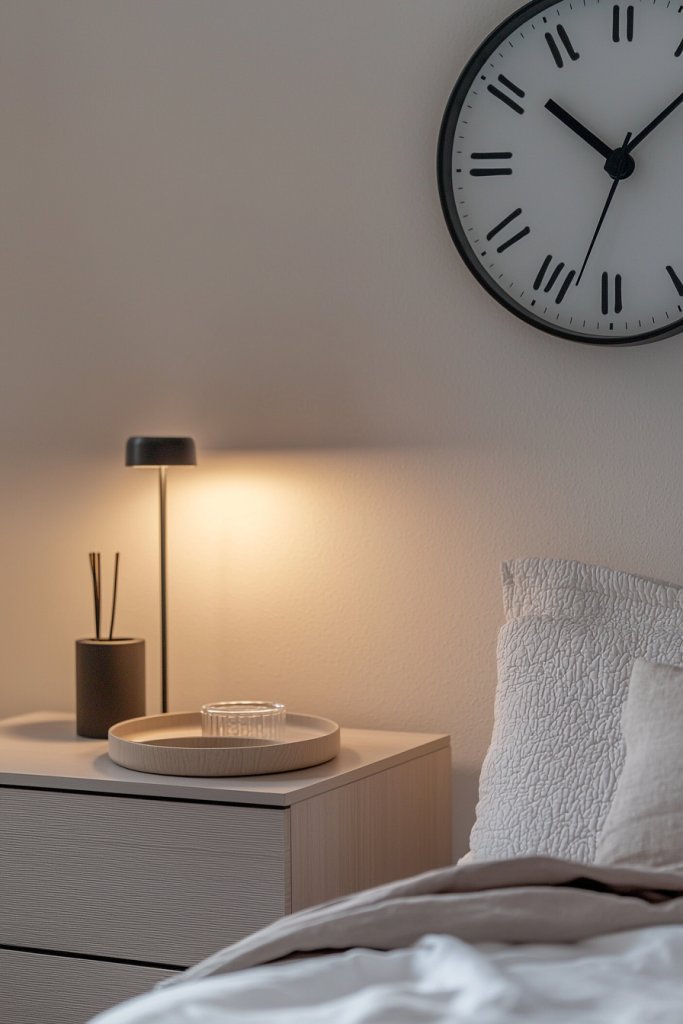
A minimalist clock and carefully chosen functional decor pieces serve both aesthetic and practical purposes in a Japandi bedroom, emphasizing simplicity and purpose. These elements help keep the space uncluttered while adding subtle design interest, reinforcing the room’s serene vibe.
The key is choosing items that blend seamlessly with the overall calm, clean lines of the style. Picture a sleek, round clock with a matte black or soft taupe face, hung unobtrusively on the wall above the bed or dresser.
Complement it with a few simple decor items like a ceramic tray for jewelry or a small, sculptural bowl for keys—each with organic shapes or muted tones. These pieces should be unadorned yet thoughtfully selected, with smooth textures and natural finishes that don’t distract but instead enhance the tranquil mood.
The goal is to create a balanced visual without overwhelming the senses. To achieve this look, pick a minimalist clock with a clean design—think thin hands and no numerals—and pair it with matching or complementary decor pieces made of ceramics, wood, or matte metals.
Keep surfaces clear and only display a few well-chosen items. These pieces are available at home decor stores or online, often at affordable prices, and can be swapped out seasonally or as your style evolves. The trick is maintaining simplicity, so your space remains calm and functional.
13. Choose Zen-Inspired Storage Solutions to Reduce Clutter
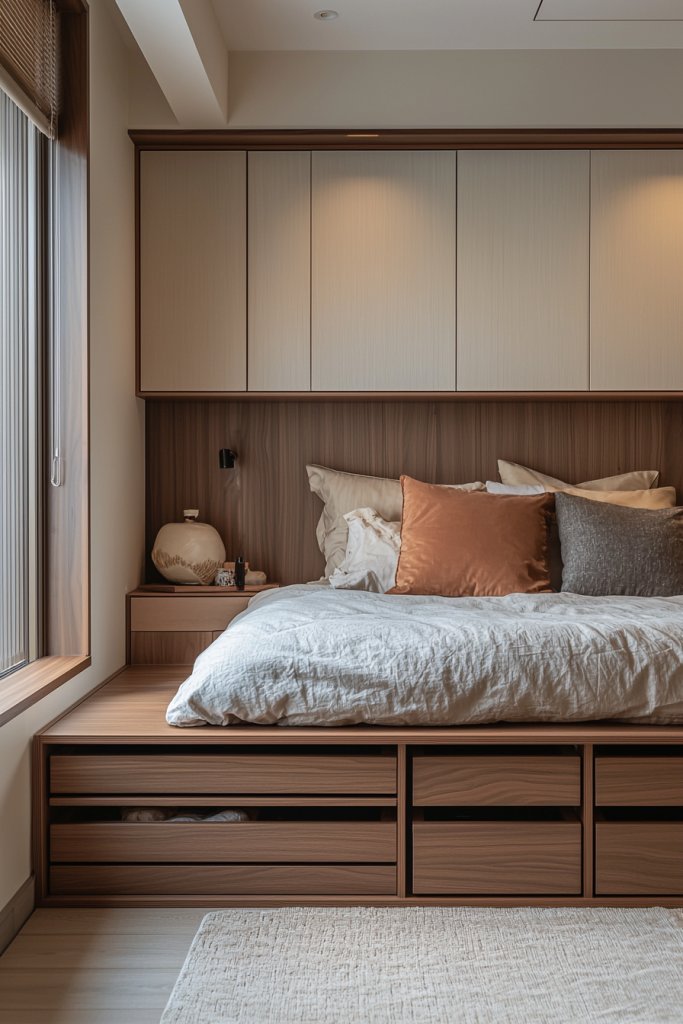
Effective storage solutions rooted in Zen principles are essential for maintaining the calm and order of a Japandi bedroom. Clutter disrupts serenity, so selecting furniture that blends seamlessly into the space while providing ample storage helps create a peaceful retreat.
These solutions focus on simplicity, functionality, and harmony, ensuring your space stays tidy and visually balanced. Imagine low-profile wooden chests, integrated under-bed drawers, or sleek wall-mounted cabinets with clean lines.
These storage options often feature natural wood finishes or matte surfaces in neutral tones, seamlessly blending into the room’s aesthetic. To keep clutter at bay, incorporate open baskets or woven trays made from natural fibers—like rattan or seagrass—for quick access to essentials, and store less-used items behind closed doors.
The key is choosing pieces that are both practical and visually unobtrusive, promoting a clutter-free environment. Start by assessing your storage needs and selecting furniture that serves dual purposes—like a bed frame with built-in drawers or a minimalistic dresser.
Use baskets or trays to organize smaller items, and keep surfaces clear of excess decor. Sourcing these storage solutions from sustainable brands or local craft stores can add an eco-friendly touch. With thoughtful planning, you’ll cultivate a tranquil bedroom that feels open, organized, and welcoming, aligning perfectly with Japandi’s core values.
14. Incorporate Soft, Linen Curtains for Privacy and Light Diffusion
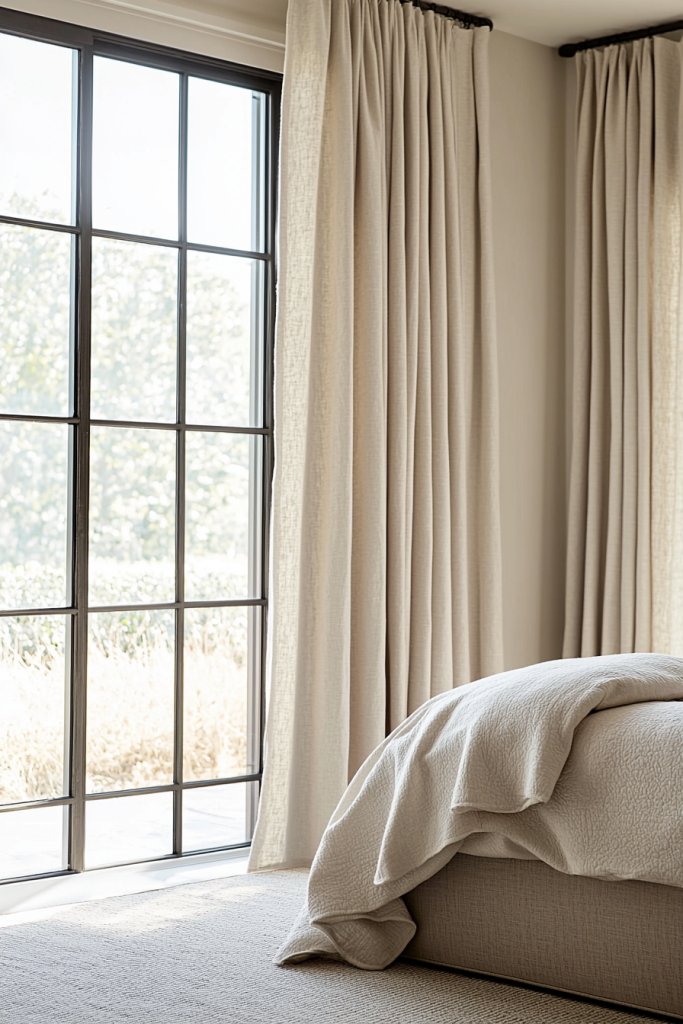
Soft linen curtains are a quintessential element in a Japandi bedroom, offering a gentle way to control natural light while enhancing the room’s cozy, understated aesthetic. Their light, airy fabric diffuses sunlight softly across the space, creating a warm, inviting atmosphere that promotes relaxation and mindfulness.
These curtains also provide privacy without feeling heavy or oppressive, maintaining the room’s openness. Visualize flowing, natural-colored linen curtains hung on simple, unobtrusive rods, framing large windows or sliding doors.
The fabric’s tactile softness invites touch, and its subtle texture adds depth to the room’s neutral palette. When closed, the curtains cast a gentle glow, evoking a sense of calm and serenity, especially in the early morning or evening.
Their natural fibers also subtly influence the room’s scent, often carrying a fresh, clean aroma that enhances the peaceful environment. To implement this, choose linen curtains in neutral tones like beige, taupe, or soft gray—colors that blend seamlessly with the overall palette.
Install simple curtain rods, preferably in matte black or brushed nickel, for a cohesive look. You can find affordable options online or at home decor stores, and they are easy to hang with basic tools.
For a personal touch, consider adding tiebacks or tie-dye accents to customize the look. These curtains are a practical, stylish way to elevate your bedroom’s tranquility and light control.
15. Use Sculptural Wooden or Ceramic Decor for Visual Interest

In a Japandi bedroom, sculptural wooden or ceramic decor pieces serve as understated focal points that add texture, form, and visual interest without disrupting the room’s minimalist harmony. These artful objects evoke craftsmanship and natural beauty, subtly drawing the eye and enriching the overall aesthetic.
Their organic shapes and tactile surfaces embody the fusion of Japanese simplicity and Scandinavian functionality. Picture a smooth, organic-shaped ceramic vase in matte earth tones or a sculptural wooden bowl with fluid curves placed on a low bedside table.
These pieces should feel intentional, with simple lines and natural finishes that echo the room’s overall calm. They can be used as accents on shelves, bedside tables, or even on the floor as standalone art objects.
The tactile quality of these decor elements invites gentle exploration, creating a peaceful visual rhythm that complements the softness of textiles and the warmth of wood. To incorporate these decor items, look for handcrafted ceramics or carved wooden sculptures at artisan markets or online shops specializing in sustainable crafts.
Keep the number of pieces minimal—one or two well-chosen objects are enough to add personality while maintaining serenity. Position them thoughtfully to serve as both decorative highlights and conversation starters. Their natural textures and organic forms will subtly enhance your space’s tranquil, balanced vibe, making your bedroom feel both intentional and calming.
16. Create a Focal Point with a Textured Headboard

A textured headboard serves as the visual anchor of a Japandi bedroom, adding depth and interest while maintaining the minimalist aesthetic. Look for headboards made from natural materials like woven rattan, linen-upholstered panels, or carved wood with tactile details.
The texture should be subtle yet noticeable—think of a soft, tactile surface that invites touch and provides contrast to smooth bedding. Choose neutral tones or muted earthy hues to keep the overall space calm and balanced, allowing the headboard to stand out gently without overpowering the room.
Picture a bed with a headboard crafted from beautifully woven rattan, its intricate pattern casting delicate shadows in the soft glow of ambient lighting. Alternatively, a linen-upholstered panel with a slightly rough, organic texture offers a cozy, grounding feel.
The headboard extends just enough to frame the bed, creating a sense of enclosure and comfort. Its tactile surface invites you to run your hand along it, adding a sensory layer that enhances the room’s tranquil vibe.
The overall effect is a harmonious blend of natural materials and understated elegance. To implement this idea, start by selecting a headboard made from natural, sustainable materials like rattan, bamboo, or linen-covered wood.
You can find ready-made pieces online or consider DIY options, such as upholstering a simple wooden frame with linen fabric for a personalized touch. If you prefer a more budget-friendly approach, attaching a textured wall panel or a large tapestry with tactile details can also serve as a focal point.
Ensure the headboard’s color complements your overall palette—stick to neutral or earthy tones for a cohesive, calming look. Mount or position it securely, and pair with minimalist bedding for a clean, serene centerpiece.
17. Emphasize Balance with Symmetrical Decor Arrangements
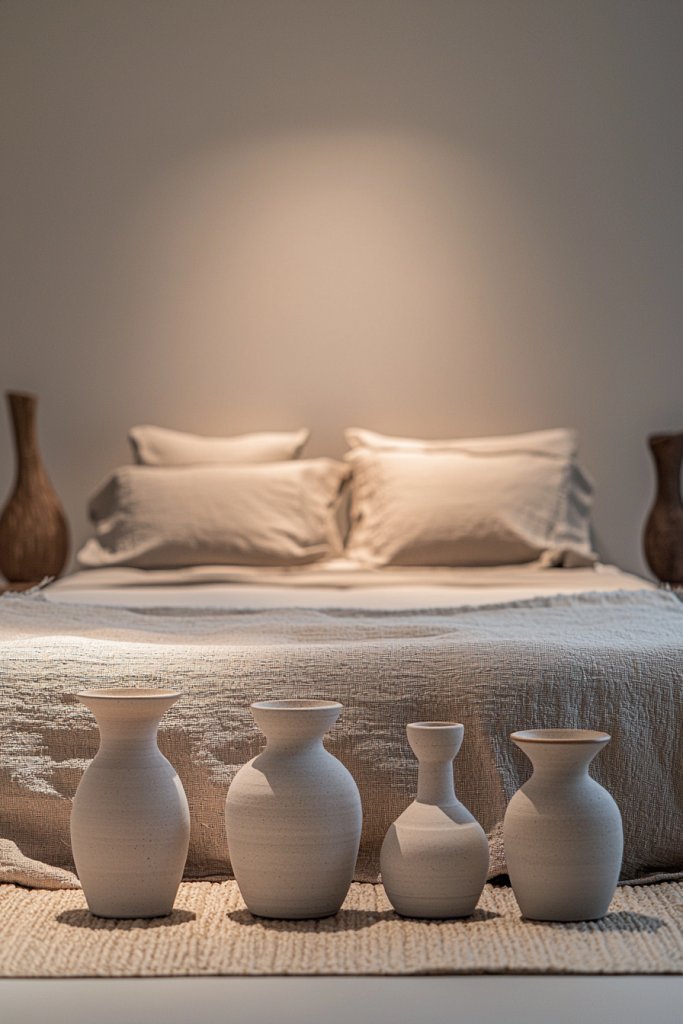
Achieving harmony in a Japandi bedroom often hinges on balanced, symmetrical decor arrangements that evoke order and calm. Start by selecting a few key decorative objects—ceramic vases, sculptural candles, or simple sculptures—that can be arranged evenly on either side of the bed or along a central shelf.
Symmetry doesn’t mean everything must be identical; instead, aim for visual balance through similar shapes, sizes, or textures. This approach visually grounds the space and creates a sense of tranquility.
Visualize a bed flanked by matching ceramic vases filled with dried grasses or minimalist sculptures that mirror each other’s form and height. On a shelf or dresser, place two identical or similar lamps that cast warm, inviting light, contributing to a cozy, symmetrical setup.
The overall arrangement emphasizes harmony, with each element carefully positioned to avoid clutter and chaos. The effect is a peaceful, balanced environment that promotes restful sleep and mental clarity.
To put this into practice, start by choosing pairs of decor items—such as vases, lamps, or small sculptures—that complement your room’s color scheme and materials. Arrange them in a mirror-image fashion on either side of your bed or across a console table.
Use visual weight—large objects on the bottom, smaller on top—to maintain proportion. Keep clutter to a minimum, and ensure each side is equally styled to foster a sense of equilibrium. This simple yet powerful technique turns your bedroom into a sanctuary of order, serenity, and subtle elegance.
18. Incorporate Layered Lighting with Floor and Table Lamps
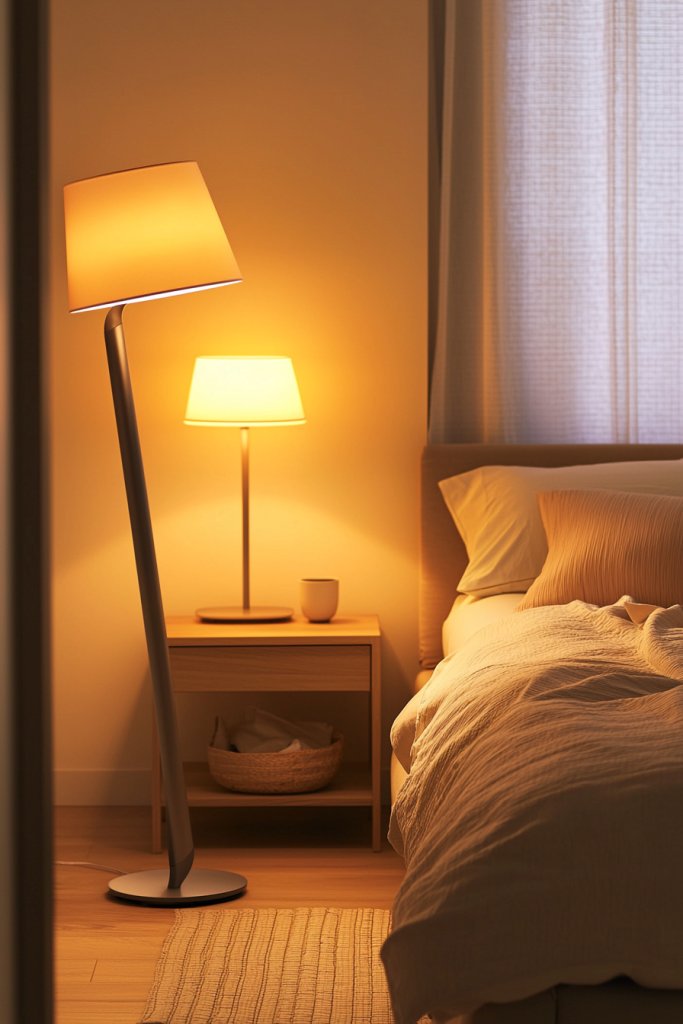
Layered lighting is essential in creating the soft, warm glow characteristic of Japandi interiors, fostering a cozy and inviting atmosphere. Combine different sources—such as a sleek floor lamp beside the bed and a small table lamp or wall-mounted sconce—to add depth and flexibility.
Opt for warm-toned light bulbs that cast a gentle, amber glow, enhancing the room’s calming vibe. The lighting should be adjustable, allowing you to create a serene ambiance for relaxing or winding down at night.
Imagine a minimalist floor lamp with a simple, matte black or brushed metal finish standing beside the bed, its warm light diffusing softly through a linen or fabric shade. A small ceramic or wooden table lamp atop a nightstand adds an intimate glow, perfect for reading or creating a tranquil environment.
Consider installing dimmer switches to control brightness levels, giving you full control over the room’s mood. The layered lighting setup ensures the space feels warm, balanced, and adaptable to different times of day or activities.
To achieve this, start with a basic floor lamp with a warm, fabric shade—look for designs with clean lines and natural finishes. Add a small bedside lamp or wall sconces with similar tones and styles for a cohesive look.
Use warm LED bulbs for energy efficiency and inviting light. Position your lighting sources thoughtfully—place the floor lamp next to the bed and the table lamp within easy reach—to maximize comfort and functionality. With a few simple pieces and adjustable settings, you can craft a layered lighting scheme that transforms your bedroom into a peaceful retreat.
19. Use Monochromatic or Subtle Patterned Bedding for Visual Harmony

In a Japandi bedroom, bedding should reinforce the overall sense of calm and cohesion through monochromatic or softly patterned designs. Choose sheets, pillowcases, and blankets in shades that are slightly varied but within the same color family—such as warm beige, cool gray, or muted blush—to create a seamless, soothing visual flow.
Gentle, subtle patterns like pinstripes, tiny checks, or tonal textures can add just enough visual interest without disrupting the tranquil aesthetic. The goal is to cultivate a space that feels unified and restful.
Visualize a bed dressed in crisp, light gray sheets, topped with a slightly darker gray duvet cover featuring a faint, tonal geometric pattern. Coordinating pillowcases with minimal detailing add layered texture, inviting touch without overwhelming the senses.
The overall look feels harmonious and sophisticated—an understated canvas that allows other design elements to shine subtly. This approach ensures your bedding enhances the room’s calm atmosphere while maintaining visual interest through simple, elegant patterns.
To implement, select bedding in a monochromatic palette or with delicate patterns that complement your room’s neutral tones. Choose natural fabrics like linen or high-quality cotton for texture and comfort.
Keep patterns subtle—think tone-on-tone designs or tiny repeats—that add depth without visual chaos. Layer with a throw blanket in a matching hue or a slightly contrasting tone for a finished look. This minimalist yet coordinated bedding style effortlessly ties your Japandi bedroom together, fostering a peaceful, cohesive environment.
20. Add a Small Seating Area with a Minimalist Lounge Chair
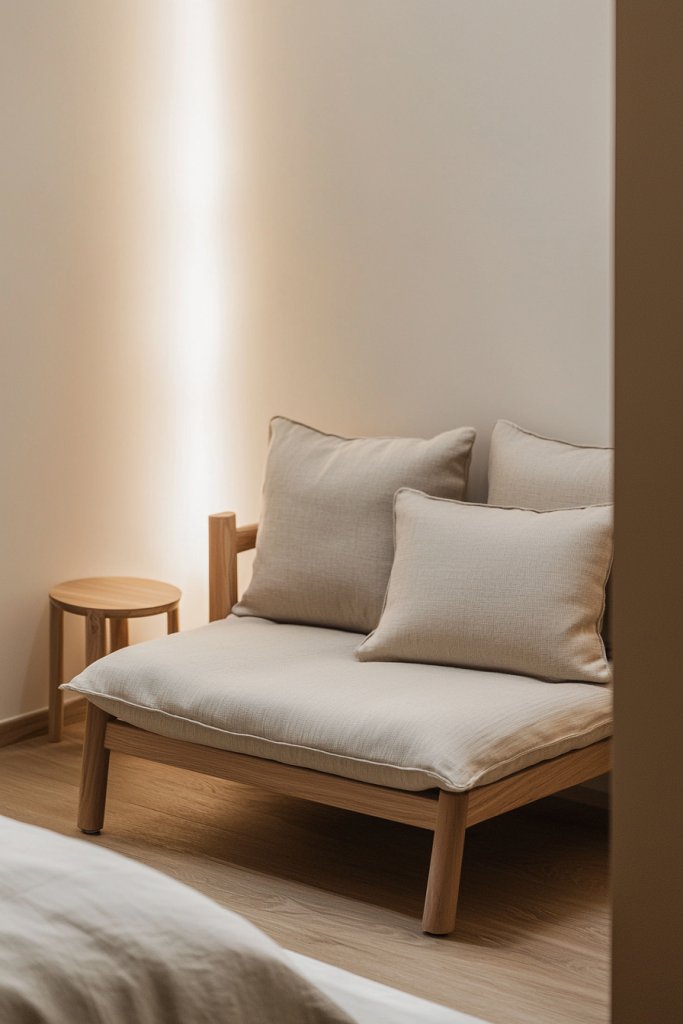
Creating a cozy yet functional seating nook in your bedroom can elevate the overall sense of serenity and balance. A small, minimalist lounge chair offers a perfect spot to unwind, read, or simply enjoy the calming space you’ve curated, making your room feel more inviting and complete.
Imagine a sleek, low-profile chair crafted from light-colored wood with clean, simple lines. It’s upholstered in a soft, neutral fabric—think beige linen or muted gray—inviting you to sink in comfortably.
Positioned near a window or in a corner, it’s complemented by a plush, textured throw blanket and a small side table holding a ceramic cup or a favorite book. The space feels airy, with natural light accentuating the gentle textures and neutral tones, creating a peaceful retreat that encourages relaxation and reflection.
To implement this idea, start by selecting a simple lounge chair with a wooden frame and understated design—think Scandinavian or Japanese-inspired styles. Pair it with a cozy throw, like a chunky knit or a soft linen blanket, and add a small side table made of natural materials such as bamboo or stone.
Place the chair in a quiet corner, ensuring it doesn’t clutter the room but rather complements your overall tranquil aesthetic. This small addition transforms your bedroom into a serene haven for moments of quiet comfort.
21. Keep Surfaces Clear with Smart Storage Solutions

A clutter-free space is essential to achieving the calm, balanced look characteristic of Japandi style. Smart storage solutions help keep everyday essentials neatly tucked away, allowing your bedroom to feel open, peaceful, and visually harmonious.
Visualize sleek, minimalist storage options such as low-profile dressers, woven baskets, or hidden compartments integrated into your furniture. These containers are made from natural materials like wood, rattan, or linen, which blend seamlessly with the room’s neutral palette.
Keep your bedside tables and shelves tidy by using small ceramic trays or boxes—think smooth, matte finishes in muted tones—to corral jewelry, keys, or personal items. The surfaces remain intentionally minimal, showcasing only a few select decor pieces or candles, which enhances the room’s serenity.
To bring this into your space, start by assessing your storage needs and choosing multi-functional furniture pieces—such as a bed with built-in drawers or a dresser with streamlined handles. Incorporate woven baskets or wooden boxes for additional organization under the bed or in closets.
Regularly declutter by removing items that don’t serve a purpose, and designate specific spots for everything. This approach keeps your bedroom effortlessly tidy, fostering a tranquil environment that invites rest and unwinding.
22. Use Natural Materials in Decorative Objects like Baskets and Trays
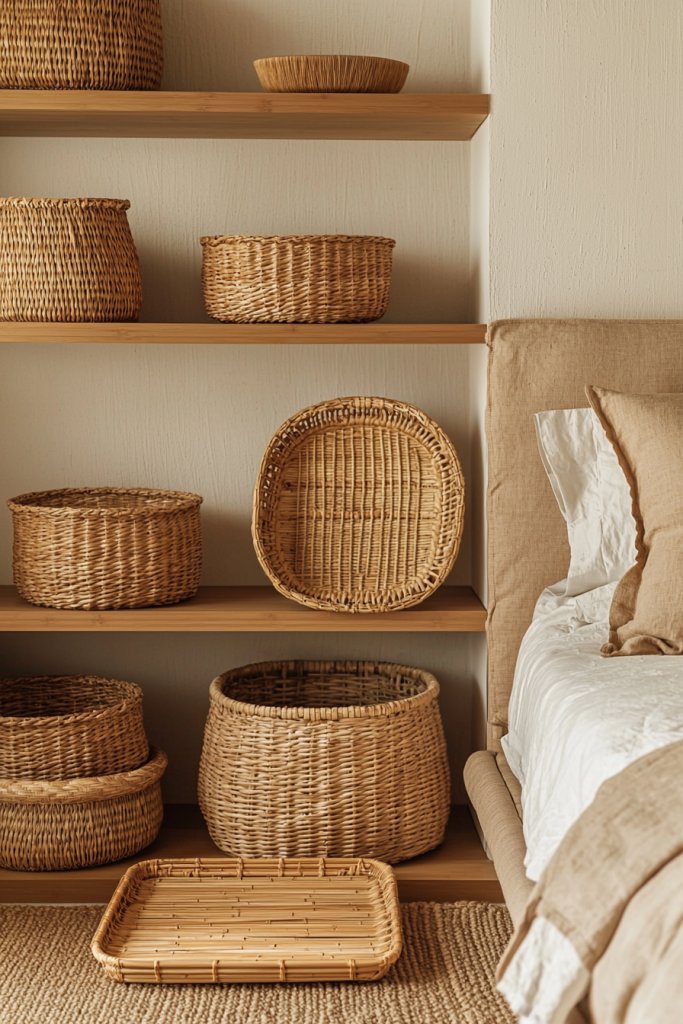
Incorporating natural materials in your bedroom decor emphasizes the organic, calming essence of Japandi style. Items like baskets, trays, and bowls crafted from materials such as rattan, bamboo, or cork add texture and warmth while maintaining a minimalist aesthetic.
Picture a set of woven rattan baskets sitting neatly in the corner or under your bed, providing stylish storage for blankets or magazines. A handcrafted bamboo tray on your bedside table holds a few essential oils or a small candle, adding tactile interest and a soothing sensory element.
These objects, with their earthy tones and textured surfaces, create visual harmony and a sense of nature indoors, making your space feel grounded and serene. Their subtle imperfections and craftsmanship evoke a sense of authenticity and calm.
To incorporate these materials, look for handmade or sustainably sourced objects at local markets or online stores specializing in eco-friendly homeware. Mix different natural textures—like a cork coaster with a rattan basket—to add depth without clutter.
Keep your decorative objects simple and functional, ensuring they serve a purpose while enhancing the room’s organic aesthetic. These touches of nature subtly reinforce the tranquil, balanced vibe that defines Japandi bedrooms.
23. Incorporate Woven or Textured Throw Pillows for Comfort

Adding woven or textured throw pillows introduces tactile richness and comfort to your bed or seating area, perfectly aligning with Japandi’s understated elegance. These pillows soften the minimalist aesthetic while offering cozy, inviting touches that enhance relaxation.
Visualize a bed dressed in crisp, neutral linens accented with a few throw pillows—perhaps a soft linen pillow with subtle embroidery or a chunky-knit cushion in muted earth tones. Their textured surfaces invite touch, and their natural fibers contribute warmth and depth to the overall decor.
The pillows may feature subtle patterns or be kept plain, but their tactile qualities are what truly make them stand out. When arranged thoughtfully, they create a layered, inviting look that beckons you to relax and unwind.
To incorporate these pillows, choose options made from natural materials like linen, cotton, or wool in calming shades such as taupe, cream, or charcoal. Mix textures—smooth, woven, and knobby—to add visual interest without overwhelming the space.
Place them casually on the bed or a cozy reading nook, and swap out seasonal covers for variety. These simple, textured accents make your bedroom feel more personal and comfortable, encouraging restful, tranquil moments.
24. Finish with a Clutter-Free, Open Space to Promote Tranquility
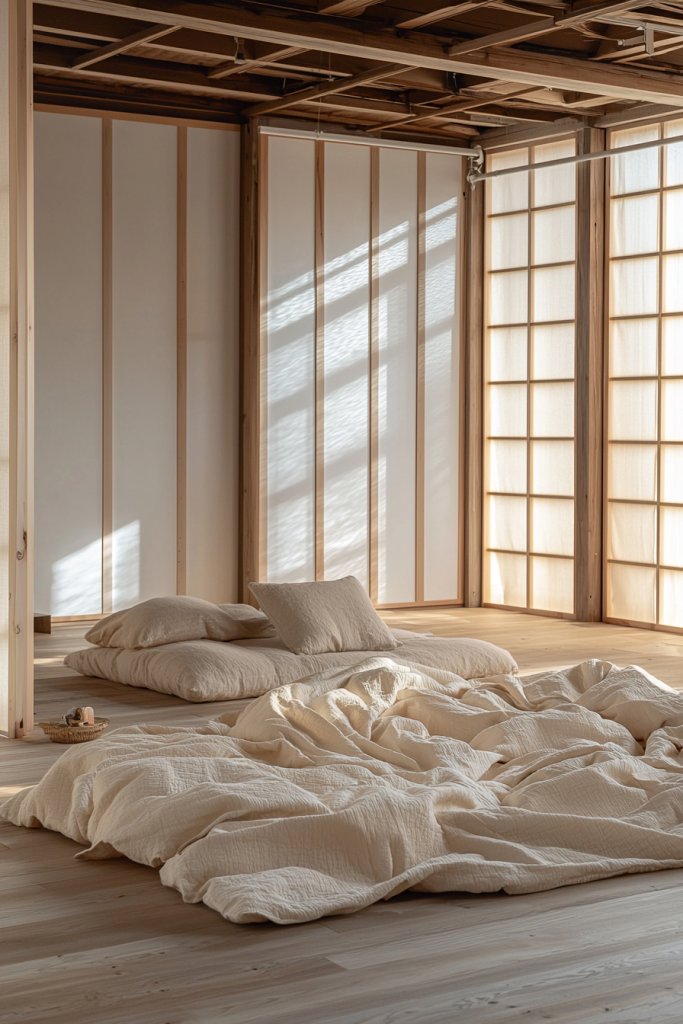
Achieving true serenity in a Japandi bedroom hinges on creating an environment that feels open and free of clutter. An intentionally spacious layout allows the mind to relax, promoting a sense of balance and mindfulness.
Imagine a room where surfaces are clear, with only a few carefully selected decor pieces—such as a single ceramic vase or a small sculpture—adding visual interest without crowding the space. Keep furniture minimal and functional, avoiding overcrowding by choosing pieces with clean lines and simple forms.
Empty corners and wide pathways contribute to a breathable, calming atmosphere, encouraging slow, mindful movement within the room. Natural light streams unimpeded, highlighting the uncluttered space and reinforcing a sense of peace.
To achieve this, start by decluttering regularly, removing items that don’t serve a purpose or add to the aesthetic. Use hidden storage solutions to stow away excess belongings, and select essential furniture that fits your space comfortably.
Keep decorative objects minimal—preferably just one or two statement pieces—and focus on maintaining an airy, open layout. This approach not only enhances the visual tranquility but also creates a sanctuary where you can truly relax and recharge.
Conclusion
These 25 Japandi bedroom ideas offer a perfect blend of serenity, simplicity, and balance, from neutral palettes and minimalist furniture to textured textiles and thoughtful lighting. By incorporating natural materials, subtle decor, and mindful organization, you can create a peaceful retreat that reflects the calm elegance of Japandi style. Give these ideas a try to transform your space into a harmonious sanctuary—your serene, balanced bedroom awaits!
Leave a Reply